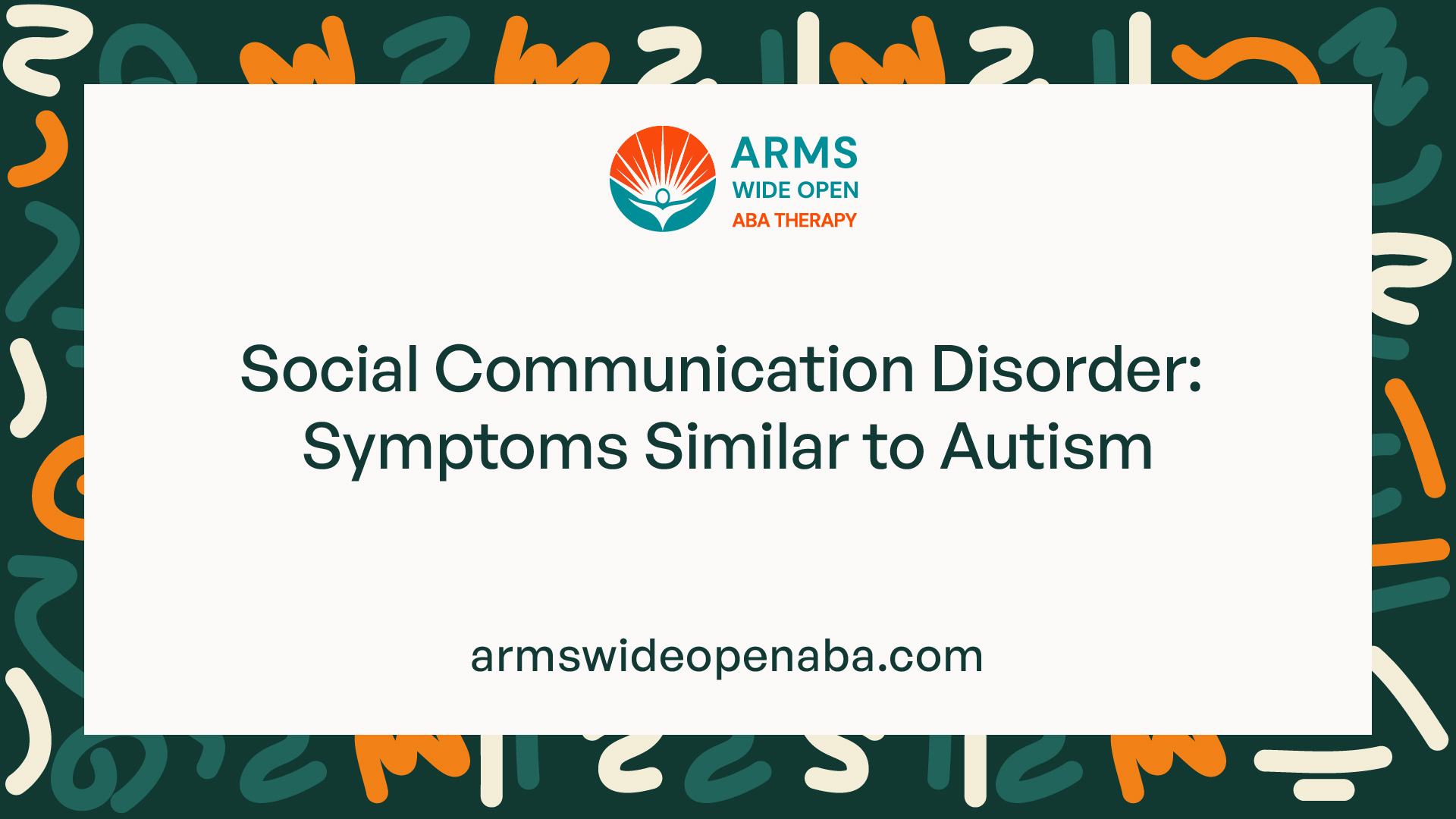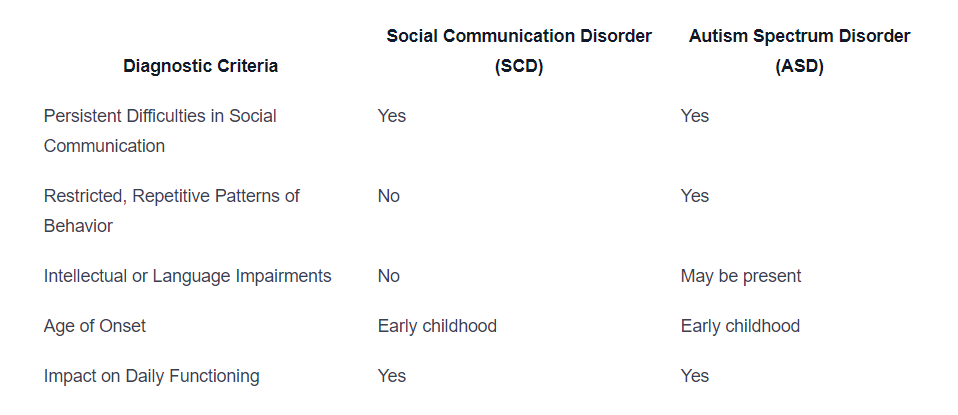Social Communication Disorder: Symptoms Similar to Autism
Discover the overlap between Social Communication Disorder (SCD) and Autism symptoms, and gain insights into diagnosis and intervention.

Understanding Social Communication Disorder (SCD)
Social Communication Disorder (SCD) is a neurodevelopmental disorder that affects an individual's ability to use verbal and nonverbal communication skills effectively in social interactions. It is characterized by persistent difficulties in social communication across various contexts. In this section, we will explore what SCD is and the diagnostic criteria used to identify it.

What is Social Communication Disorder?
Social Communication Disorder (SCD) is a condition that primarily impacts a person's ability to understand and use language in social situations. Individuals with SCD may struggle with understanding and appropriately interpreting verbal and nonverbal cues, making it challenging for them to engage in effective communication and establish social relationships.
Unlike individuals with autism spectrum disorder (ASD), those with SCD do not exhibit restricted and repetitive behaviors or interests. Instead, their challenges are primarily related to social communication difficulties. It's important to note that SCD can co-occur with other conditions, such as ADHD or specific learning disorders.
Diagnostic Criteria for SCD
To diagnose Social Communication Disorder, clinicians refer to the diagnostic criteria outlined in the Diagnostic and Statistical Manual of Mental Disorders (DSM-5). The DSM-5 provides specific guidelines and criteria that must be met for an individual to receive an SCD diagnosis.
The diagnostic criteria for SCD include:
- Difficulties in using verbal and nonverbal communication for social purposes, such as greeting others or engaging in conversation.
- Impairment in the ability to change communication to match the context or needs of the listener, such as using different language or tone of voice when talking to different people.
- Challenges in following rules for conversation and storytelling, such as taking turns during a conversation or providing relevant information when sharing a story.
- Difficulty understanding what is not explicitly stated and inferring meaning from social situations, such as understanding sarcasm or implied requests.
- These difficulties are evident in early childhood but may become more apparent as social demands increase.
It is important to note that the symptoms of SCD must not be better explained by another condition, such as ASD or intellectual disability. A comprehensive evaluation and assessment by a qualified professional are necessary to determine an accurate diagnosis.
Understanding the characteristics and diagnostic criteria of Social Communication Disorder is essential for early identification and appropriate intervention. By recognizing the unique challenges faced by individuals with SCD, we can provide the necessary support and create inclusive environments that foster effective communication and social interaction.
Overlapping Symptoms with Autism
Individuals with Social Communication Disorder (SCD) may exhibit symptoms that are similar to those associated with Autism Spectrum Disorder (ASD). In this section, we will explore the overlapping symptoms between SCD and autism, specifically focusing on difficulties in social interaction and challenges in communication.
Similarities in Social Interaction Difficulties
Both SCD and autism share commonalities in terms of difficulties with social interaction. Individuals with both conditions may struggle with understanding nonverbal cues, maintaining eye contact, and engaging in reciprocal conversations. These challenges can impact the formation of friendships, social connections, and the ability to navigate social situations effectively.
Social Interaction Challenges
Difficulty understanding nonverbal cues
Struggles with maintaining eye contact
Challenges in engaging in reciprocal conversations
Shared Challenges in Communication
Communication difficulties are another area where SCD and autism symptoms overlap. Both conditions can affect various aspects of communication, including expressive language (the ability to express oneself), receptive language (the ability to understand others), and pragmatic language (the appropriate use of language in social contexts).
Individuals with SCD and autism may experience challenges in initiating and sustaining conversations, understanding idioms or sarcasm, and following social rules related to conversation. These difficulties can impact everyday interactions and may lead to misunderstandings or misinterpretations.
Communication Challenges
Difficulties in initiating and sustaining conversations
Challenges in understanding idioms or sarcasm
Trouble following social rules related to conversation
Understanding the overlapping symptoms between SCD and autism is crucial for accurate diagnosis and appropriate intervention. While there are similarities, it's important to differentiate between the two conditions to ensure individuals receive the support and resources they need. In the next section, we will explore the key distinctions in diagnostic criteria that help differentiate SCD from autism.
Differentiating SCD from Autism
When it comes to understanding social communication disorders (SCD) and their relationship to autism, it's important to recognize the key distinctions between the two. While SCD shares some symptoms with autism, there are specific criteria that set them apart.
Key Distinctions in Diagnostic Criteria
The diagnostic criteria for social communication disorder (SCD) and autism spectrum disorder (ASD) help differentiate between the two conditions. Here are some key distinctions:

While both SCD and ASD involve difficulties in social communication, SCD does not have the restrictive and repetitive behaviors characteristic of ASD. Individuals with SCD may have challenges in initiating and maintaining conversations, understanding nonverbal cues, and interpreting social situations. However, they do not exhibit the repetitive behaviors and restricted interests often seen in individuals with ASD.
Focus on Social Communication vs. Restrictive Repetitive Behaviors
A key distinction between SCD and ASD lies in the primary focus of the conditions. SCD primarily affects social communication skills, including the use of verbal and nonverbal language, understanding social cues, and engaging in reciprocal conversations. In contrast, ASD encompasses a broader range of symptoms, including both social communication difficulties and restrictive, repetitive behaviors or interests.
While individuals with SCD may struggle with social interaction and communication, they do not display the repetitive behaviors or intense preoccupations often seen in individuals with ASD. This differentiation is important for accurate diagnosis and appropriate intervention strategies for individuals with these conditions.
Understanding the differences between SCD and ASD is crucial for professionals in the field of neurodevelopmental disorders, as well as for individuals seeking to understand and support those affected by these conditions. By recognizing the distinct diagnostic criteria and the focus on social communication in SCD, we can promote accurate identification, intervention, and support for individuals with these conditions.
Co-Occurrence of SCD and Autism
Social Communication Disorder (SCD) and Autism are two neurodevelopmental conditions that share similarities in their symptoms and characteristics. Understanding the co-occurrence of these disorders can provide insight into their relationship and guide appropriate interventions. In this section, we will explore statistics and research findings regarding the co-occurrence of SCD and Autism, as well as common comorbidities and shared treatment approaches.
Statistics and Research Findings
While Social Communication Disorder (SCD) and Autism are distinct disorders, they often co-occur, meaning that an individual can be diagnosed with both conditions simultaneously. Research studies have shed light on the prevalence of this co-occurrence and the challenges it presents.

These statistics highlight the significant overlap between SCD and Autism. They indicate that a substantial proportion of individuals diagnosed with Autism also exhibit symptoms of SCD, and vice versa.
Common Comorbidities and Shared Treatment Approaches
Comorbidities refer to the presence of multiple disorders or conditions in an individual. When it comes to SCD and Autism, there are several comorbidities that are commonly observed. Understanding these comorbidities can help professionals tailor treatment approaches to address the specific needs of individuals with co-occurring SCD and Autism.
Some common comorbidities associated with both SCD and Autism include:
- Intellectual disability
- Attention Deficit Hyperactivity Disorder (ADHD)
- Anxiety disorders
- Language impairment
- Sensory processing difficulties
Treating individuals with co-occurring SCD and Autism requires a comprehensive and individualized approach. While there is no one-size-fits-all treatment, there are shared approaches that can be beneficial in addressing the challenges associated with these conditions.
Shared treatment approaches for SCD and Autism may include:
- Speech and language therapy: To enhance communication skills and improve social interaction.
- Social skills training: To develop social communication skills, including non-verbal cues and understanding social contexts.
- Occupational therapy: To address sensory processing difficulties and improve daily functioning.
- Applied Behavior Analysis (ABA): A behavior-based intervention to target specific behaviors and improve adaptive skills.
- Cognitive Behavioral Therapy (CBT): To address anxiety and other emotional difficulties.
It is important to note that treatment approaches should be tailored to the specific needs and strengths of each individual. A multidisciplinary team, including professionals such as speech-language pathologists, psychologists, and occupational therapists, can work collaboratively to develop and implement a comprehensive treatment plan.
Understanding the co-occurrence of SCD and Autism provides valuable insights into the complexities of these disorders. By recognizing the shared symptoms and utilizing appropriate interventions, individuals with co-occurring SCD and Autism can receive the support they need to thrive and reach their full potential.
Seeking Support and Intervention
When it comes to addressing social communication disorder (SCD) and autism, seeking support and intervention is crucial for individuals and their families. Early identification and diagnosis, along with appropriate therapeutic approaches and a supportive environment, play a vital role in helping individuals with these conditions thrive.
Early Identification and Diagnosis
Early identification and diagnosis of SCD and autism are key to ensuring timely intervention and support. Recognizing the signs and symptoms can help parents, caregivers, and healthcare professionals take the necessary steps to address the challenges faced by individuals with these conditions.
It's important to consult with a healthcare professional who specializes in developmental disorders to obtain an accurate diagnosis. They will evaluate various factors, including the individual's social communication skills, behavior patterns, and developmental history. Diagnostic tools such as the DSM-5 criteria or other standardized assessments may be used to aid in the diagnosis.
Therapeutic Approaches for SCD and Autism
Therapeutic approaches play a significant role in supporting individuals with SCD and autism. These approaches aim to improve social communication skills, enhance overall development, and address specific challenges associated with these conditions.
Some common therapeutic approaches for SCD and autism include:
- Speech and Language Therapy: This type of therapy focuses on improving communication skills, including verbal and nonverbal communication, conversation, and social interaction. It can also help individuals develop strategies to manage challenges related to language comprehension and expression.
- Occupational Therapy: Occupational therapy focuses on developing skills necessary for daily living activities, such as self-care, motor skills, sensory processing, and social participation. It can help individuals with SCD and autism enhance their independence and functional abilities.
- Applied Behavior Analysis (ABA): ABA is a structured therapy that uses principles of learning theory to address behavioral challenges and teach new skills. It can be effective in improving social interaction, communication, and reducing repetitive behaviors.
- Social Skills Training: Social skills training programs aim to teach individuals with SCD and autism appropriate social behaviors, emotional regulation, and problem-solving skills. These programs often involve structured group activities and role-playing exercises.
Building a Supportive Environment
Creating a supportive environment is essential for individuals with SCD and autism to thrive. This involves a collaborative effort from parents, educators, and healthcare professionals. Here are some strategies to build a supportive environment:
- Promote understanding and acceptance: Educate family members, friends, and classmates about SCD and autism to foster empathy and reduce stigma.
- Individualized education plans: Work with educators to develop customized education plans that address the specific needs of individuals with SCD and autism. This may include accommodations, modifications, and specialized support services.
- Social support networks: Connect with support groups, online forums, and local organizations that provide resources and a sense of community for individuals and their families.
- Sensory-friendly environments: Create sensory-friendly spaces that minimize sensory overload and cater to the specific sensory needs of individuals with SCD and autism.
By seeking early identification and diagnosis, implementing appropriate therapeutic approaches, and building a supportive environment, individuals with SCD and autism can receive the necessary support to navigate social communication challenges and reach their full potential.
Sources
https://www.additudemag.com/social-communication-disorder-autism-adhd/
https://www.webmd.com/brain/autism/autism-similar-conditions
https://www.verywellhealth.com/what-is-social-communication-disorder-260230
Similar articles
We’re here to help you

Our team is here to assist you in this process. Contact us for any assistance.
it’s easy to apply
We Accept Most Insurances
Our in-network insurance partnerships make ABA therapy more accessible to families throughout our service areas.







Our Insurance Process
We'll request your insurance details to help us verify your plan's coverage for ABA therapy. Once we've received this information, we'll walk you through your benefits, including copayments, deductibles and out-of-pocket maximums, so you know what to expect in advance.
Our team will then handle the preauthorization and all the necessary paperwork.
.svg)





















.jpeg)


































.jpeg)




.jpeg)







.jpeg)











.jpeg)
















